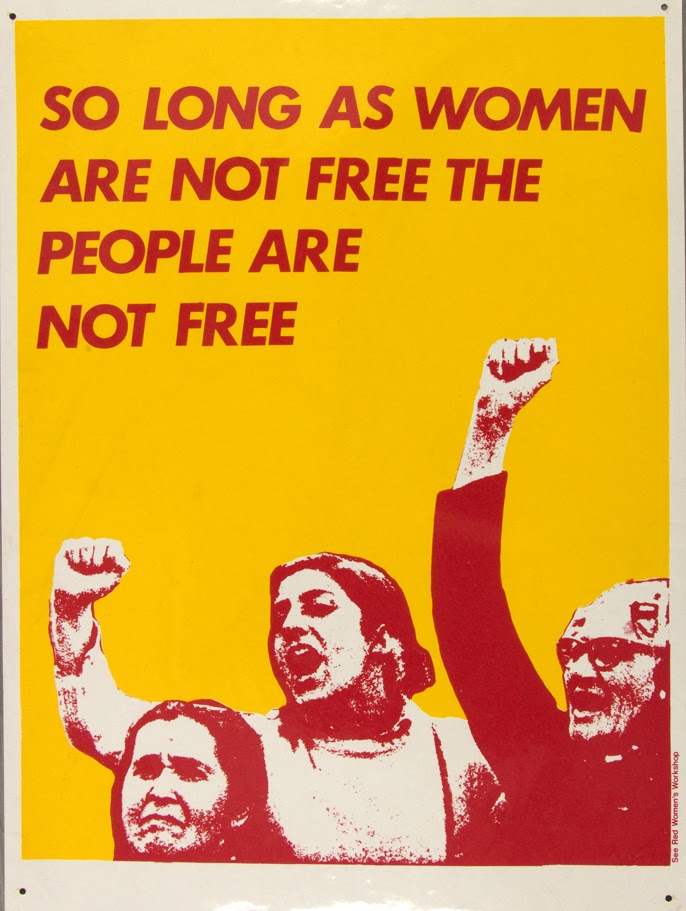
A History of American Protest
.
The timeline of protest as it was installed for 20/20 InSight: Posters from the 2017 Women’s March
When I was tasked with cataloging and curating 20/20 Insight: Posters from the 2017 Women’s March, I found myself sorting through signs filled with a multitude of issues. Most were concerned with these repeating slogans: Women’s Rights are Human Rights, Black Lives Matter, No Human is Illegal, Science is Real, and Love is Love.
As I pondered how to organize a show out of these issues it occurred to me that we have been fighting for these concerns longer than the current administration had been in office, which at that moment, was one day.
Using those rallying cries as headlines, I began to research the protest history of the United States.
Women’s Rights are Human Rights

So Long As Women Are Not Free
See Red Women’s Workshop, 1978
March 3, 1913
WOMEN’S SUFFRAGE MARCH
The first organized political march in Washington D.C. was planned by women fighting for the right to vote. They built floats, wore costumes, and were led by activist Inez Milholland riding a white horse. U.S. conventions addressing women’s rights date back to 1848, but this 1913 march set off a seven-year fight that resulted in the Nineteenth Amendment, prohibiting voter discrimination based on sex. 2020 marks the 100th year that women have had the right to vote in America. The United States is 243 years old.
October 1921–Present Day
EQUAL RIGHTS AMENDMENT
Introduced for the first time in 1921, the Equal Rights Amendment was presented in every congressional session between then and 1972, when it finally passed the House and Senate. The Amendment served to guarantee equality between men and women, but it devolved into a debate about gender roles. Politicians scared women by telling them they would be drafted in times of war, or they might not receive alimony or custody of their children in a divorce. The deadline for the Amendment to be ratified by the remaining states has been extended several times, and, as of today, only 37 states have approved it.
March 21, 1969
ABORTION SPEAK OUT
Before Roe v. Wade was decided in 1973, each state had its own set of laws governing abortion. The Abortion Speak Out was organized to protest the male-only (and one nun) legislative hearing that was reviewing the state laws of New York. Twelve women spoke openly about their abortions in front of a crowd of hundreds, storming the hearing and demanding that real experts on the subject be heard. Abortion was made legal in the U.S. in 1973, after an all-male Supreme Court ruled that women had the right to choose.

Inez Milholland, wearing a white cape while seated on white horse, at the National American Woman Suffrage Association parade, March 3, 1913 (Credit: F A Archive/REX/Shutterstock)
1986, 1989, 1992, & 2004
MARCH FOR WOMEN’S LIVES
The March for Women’s Lives has been an ongoing effort to bring attention to reproductive freedom. Held over many years with ever-increasing numbers of protesters, the demonstrations sought to fight off encroachments on a woman’s right to choose. Organized by the National Organization for Women, an estimated 80,000 people participated in the first march.
May 2014
#YESALLWOMEN
#YesAllWomen became a popular Twitter hashtag in which users share stories of misogyny and violence against women. Twitter has become a popular place of protest, spawning other hashtags like: #SayHerName (2015) meant to raise awareness for black female victims of police brutality and anti-black violence in the United States, #ShoutYourAbortion (2015) tweets about experiences expressed without shame or regret to destigmatize abortion, #MeToo (2017) used to talk about sexual assault and harassment in the workplace, made more well known with support from the entertainment industry. Social media, in some cases, may be a replacement for taking to the streets, but also a compelling way to organize physical protests.
Black Lives Matter
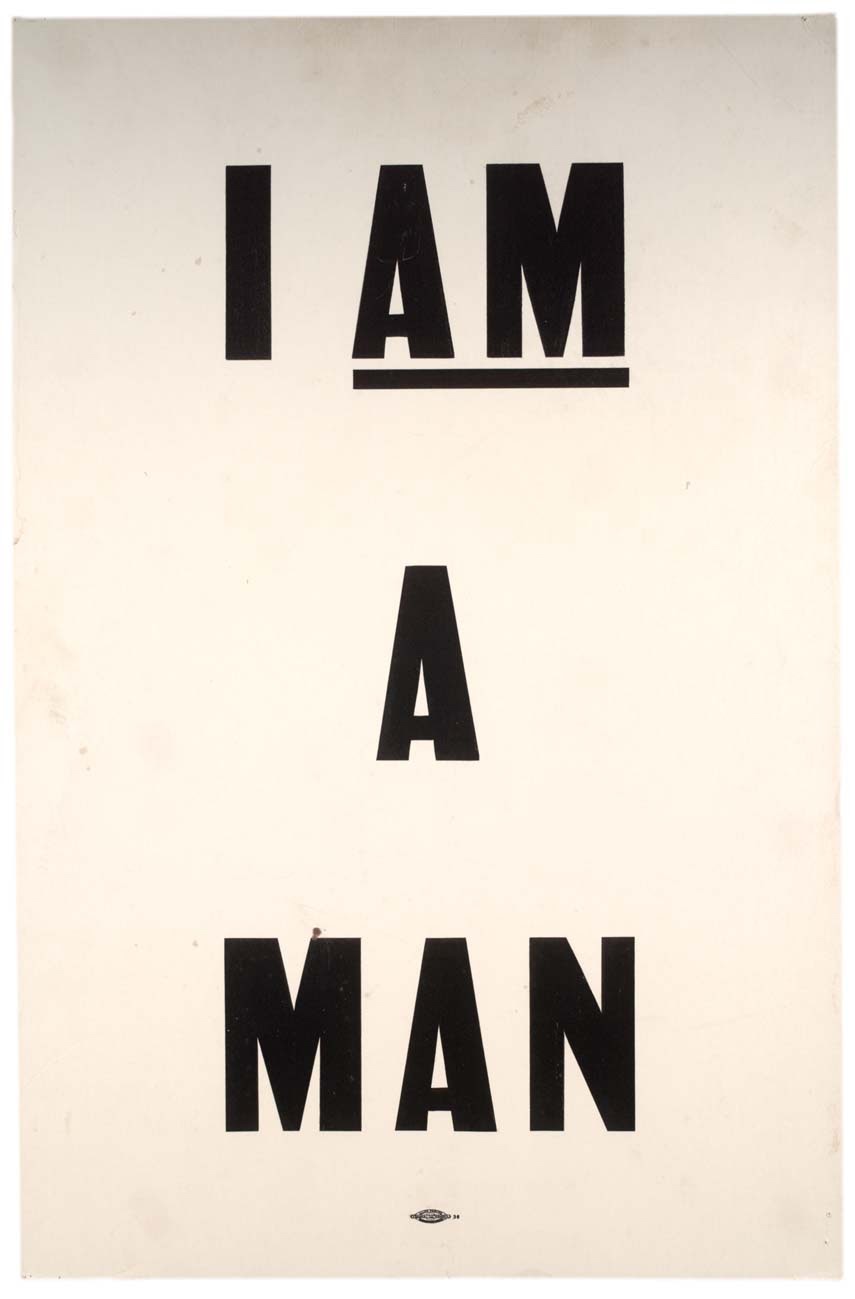
I Am A Man
Designer Unknown, 1968
July 28, 1917
THE NEGRO SILENT PROTEST PARADE
As a reaction to a wave of violence against African Americans in the South, NAACP leaders James Weldon Johnson and W.E.B. DuBois created a committee for a protest parade in 1917. Eighty-five years earlier, freed black people were prohibited from congregating in large groups in the South after Nat Turner’s Rebellion. But the Negro Silent Protest Parade gathered 10,000 African American women, children, and men who silently marched down 5th Avenue as a show of solidarity in support of racial reform.
December 1, 1955–December 20, 1956
MONTGOMERY BUS BOYCOTT
When Rosa Parks refused to give up her seat on a bus to a white man, she was thrown in jail. Four days later, the black community organized a boycott of the bus system that would last for 381 days. Considered by many to be the start of the Civil Rights Movement, this boycott convinced the U.S. Supreme Court to order the integration of the bus system nationwide.
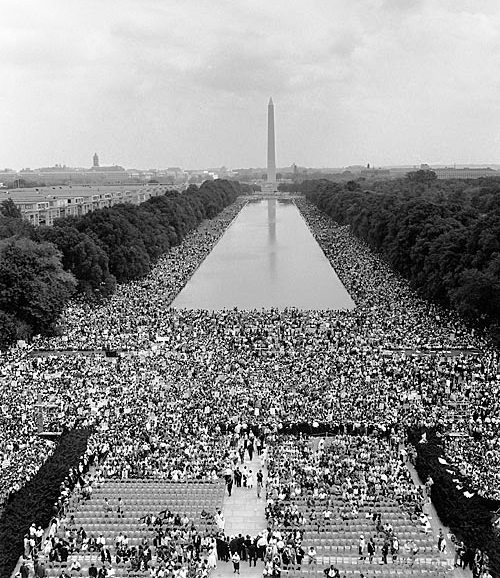
The March on Washington for Jobs and Freedom in 1963 is where MLK delivered his famous “I Have a Dream” Speech
August 28, 1963
MARCH ON WASHINGTON FOR JOBS AND FREEDOM
In 1941, A. Philip Randolph threatened a 50,000-person march on Washington to protest discriminatory hiring in war industries, resulting in the Fair Employment Act. In 1963, he co-organized the March for Jobs and Freedom, attended by an estimated 250,000 people. Years in the making, the timing of the march was escalated by a series of violent clashes in the South between police, non-violent protestors, and other citizens. At the march, unions like the American Auto Workers provided posters to protesters, who listened to performances and speeches including MLK’s famous “I Have A Dream” speech.
February 12– April 16, 1968
MEMPHIS SANITATION STRIKE
After two sanitation workers were killed due to a faulty garbage truck, workers fed up with a lack of safety measures created a labor union to strike for improved working conditions and wage increases. Using non-violent civil disobedience, the protesters found themselves in an increasingly volatile atmosphere. The violence culminated in the assassination of Martin Luther King Jr., who had been in support of the strike and present at many gatherings. The protest continued after his death and gained recognition of the sanitation union, wage increases, and improved conditions.

The continuing protest for Black Lives Matter takes many forms and takes place both digitally and in physical locations
2013–Present Day
BLACK LIVES MATTER
In response to the acquittal of Trayvon Martin’s shooter, three women—Alicia Garza, Patrisse Cullors, and Opal Tometi—created a political movement using the Twitter hashtag #BlackLivesMatter. This hashtag turned into physical protest after Mike Brown was fatally shot while trying to surrender to the police in Ferguson, MO. Using the hashtag as an organizational tool, BLM was able to respond to the racially-motivated murder by coordinating a bus ride of protesters they called the Black Lives Matter Ride, echoing Freedom Rides of the Civil Rights Movement. With a global network of over 40 chapters, BLM continues to focus their efforts on speaking out against police killings of black people and broader issues such as racial profiling, police brutality, and racial inequality in the United States criminal justice system.
No Human Is Illegal
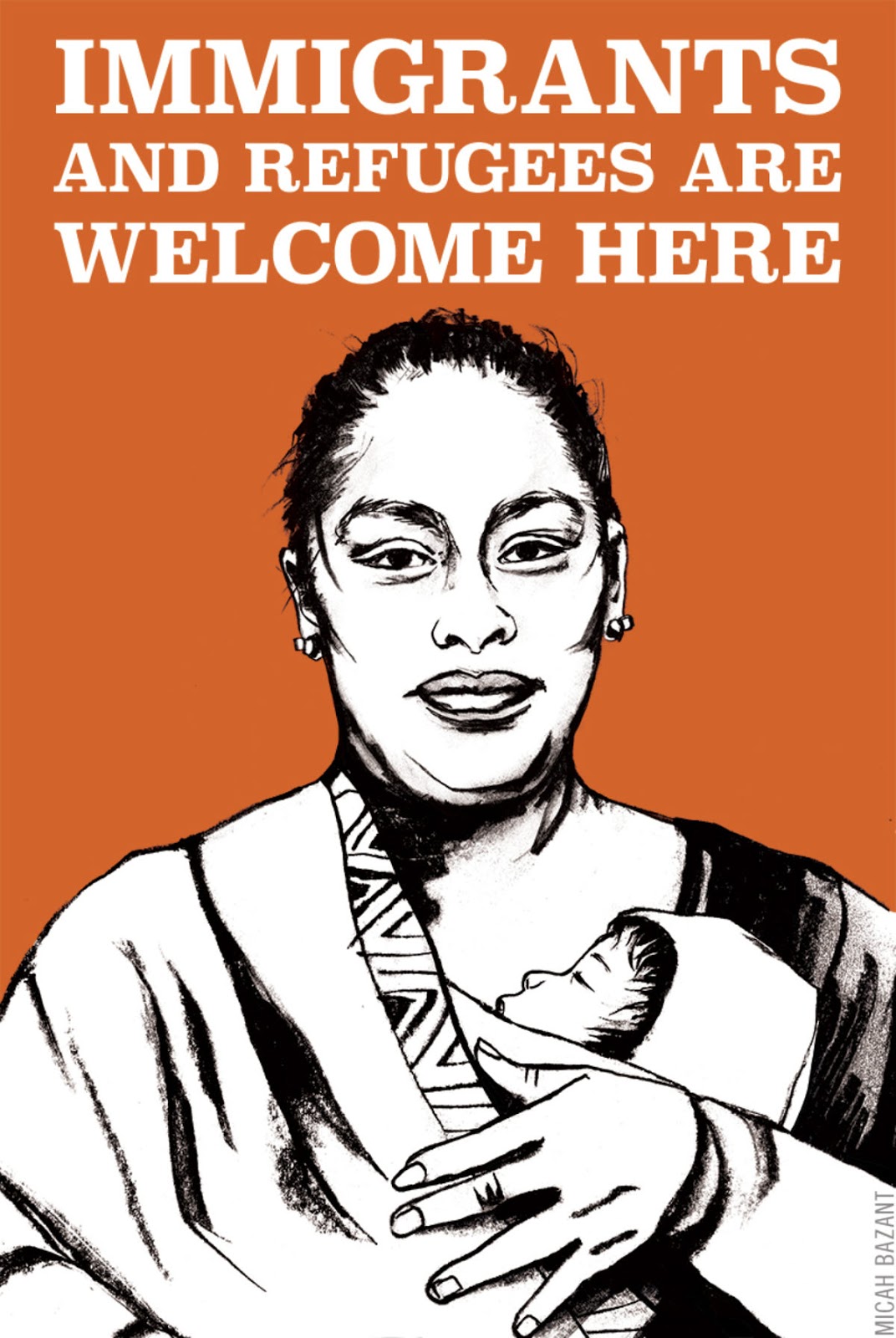
Immigrants And Refugees Are Welcome Here
Micha Bazant, 2017
October 12, 1933
ILGWU
Working conditions for Los Angeles garment workers had gotten so appalling that Rose Pesotta, an immigrant from Ukraine, along with fellow union organizer Anita Andrade Castro, led a successful strike for the International Ladies Garment Workers’ Union. The strike led to increased wages and made working conditions better for the mostly undocumented Mexicans that staffed Los Angeles’s garment factories.
September 8, 1965–1970
UNITED FARM WORKERS
American growers have long used undocumented labor on U.S. farms. The 1942 Bracero program was a series of laws that guaranteed proper treatment and fair wages to workers brought in from other countries while the American workforce was depleted by war. However, the immigration system would catch and deport undocumented workers, but never sanction the farms that employed them. Workers were always at a disadvantage, and unions were needed.
Co-founded by Dolores Huerta and Cesar Chavez, the United Farm Workers Union formed as a result of the five year Delano Grape Strike, which merged the unions of Mexican and Filipino laborers. Their assembled efforts over five years improved working conditions and wages for the largely immigrant worker community and created a longstanding union that continues to advocate for undocumented farm laborers today.
May 1, 2006
DAY WITHOUT AN IMMIGRANT
Coinciding with May Day, this was a one-day boycott of schools and businesses by immigrants in the United States. Participants were encouraged not to buy, sell, work, or attend school to illustrate how many undocumented workers are working in and necessary to the United States. The rallies called for general amnesty and legalization programs for undocumented workers.
January/February 2017
MUSLIM BAN PROTEST
On January 27, President Trump signed an executive order—nicknamed the Muslim ban—which suspended the admission of all refugees entering the U.S. for 120 days, with an indefinite block for Syrian refugees. The order barred citizens from Iran, Iraq, Libya, Sudan, Syria, and Yemen from entering the U.S. for 90 days. Almost 2,000 protesters rushed to airports in New York City, with many other cities joining in throughout the coming months. The order sped through the judicial system, often receiving a stay of execution until it finally reached the Supreme Court, which upheld a slightly modified version of the ban.
June 30, 2018
FAMILIES BELONG TOGETHER
Families Belong Together is a grassroots organization formed in response to increasing focus on immigration into the United States from its southern border, and the separation of children from their families. In 2018, Families Belong Together organized a series of protests that ended in a keynote event on June 30 that attracted tens of thousands of people to Washington D.C. and approximately 700 other U.S. cities. These protests brought attention to the systematic criminalization of immigrants and accelerated ICE raids by the Trump administration. The Washington D.C. protest saw demonstrators numbering 50,000, while other cities saw as few as 100.
Science Is Real
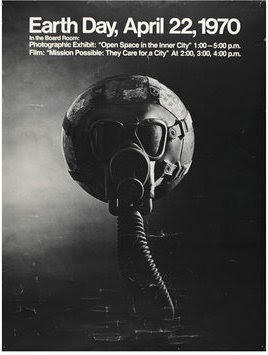
Earth Day, April 22, 1970
Robert Leydenfrost (design) & Don Brewster (photo), 1970
1917
SAVE THE REDWOODS LEAGUE
Three conservationists on a road trip discovered 300-year-old Redwood trees being felled to create vineyard stakes, shingles, and railroad ties. To halt further destruction, they decided to purchase the land to preserve the ancient trees and created a network of 66 parks totaling more than 200,000 acres of Redwood forest.
April 22, 1970
1ST EARTH DAY
In 1969, a 4.2 million gallon oil spill off the coast of Santa Barbara became the most devastating environmental disaster in human history, destroying hundreds of miles of California coastline. This catastrophe sparked a teach-in on environmental subjects initiated by Gaylord Nelson (Democratic Senator from Wisconsin) and Paul McCloskey (Republican Congressman from California) that was the genesis of the first Earth Day. College campuses, local libraries, and other public forums hosted the teach-ins developed by residents, eventually spawning the catchphrase, “Think globally, act locally.”
1995–99
WARD VALLEY PROTEST
Native American lands have long been targeted as a dumping ground for nuclear waste as well as storage and testing of atomic weapons. On a site slated for a nuclear waste dump, activists from the five Colorado River basin tribes—Fort Mojave, Chemehuevi, Cocopah, Quechan, and Colorado River Indians—built an encampment to prevent such detrimental action. The land was important for many reasons: it was the main water source for surrounding communities and was considered by many tribes to be central to their traditional creation narrative. The protest and occupation lasted for four years until they successfully thwarted the plans for the toxic site.
April 2016
DAKOTA ACCESS PIPELINE PROTESTS
The Keystone pipeline, a massive multi-phase oil pipe that runs from Texas to Canada, was set to be routed through lands belonging to the Standing Rock Indian Reservation. Objectors to the pipeline included people who thought it would pollute water and disturb native burial grounds, as well as environmentalists who believe that the U.S. depends too heavily on fossil fuels. Protests started in April 2016, but by February 2017 the number of demonstrators had dwindled due to arrests and harsh treatment. Under the Trump Administration, the pipe was completed in April 2019.
April 29, 2017
PEOPLE’S CLIMATE MARCH
The People’s Climate Movement announced the demonstration in January 2017 to protest the environmental policies of President Donald Trump, which include a campaign promise to dismantle the EPA and prioritize economic growth over the preservation of resources and the environment. The protests were held at the end of his first 100 days as president during stormy weather across the U.S. There were an estimated 200,000 participating in the D.C. march.
Love Is Love
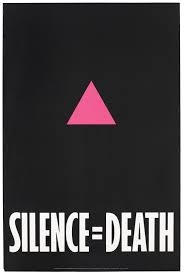
Silence = Death
Avram Finkelstein, 1987
June 28, 1969
STONEWALL RIOTS
The struggle for visibility and basic rights for the LGBTQ+ community has been ongoing. As early as 1924, the Society for Human Rights was established in Chicago but disbanded as members were quickly arrested. During the “Lavender Scare” of the 1950s, the U.S. Government fired homosexuals in droves, forcing them underground. In June of 1969, an early-morning raid on the Stonewall Inn led to a bloody confrontation between the New York City Vice Squad Public Morals Division and a frustrated LGBTQ+ community. After several nights of protesting, the brutal crackdown ultimately spurred an organized mass movement for the rights and acceptance of LGBTQ+ people. June is now considered Pride Month in recognition of this conflict.
October 14, 1979
NATIONAL MARCH ON WASHINGTON FOR LESBIAN AND GAY RIGHTS
One hundred twenty-five thousand gay men, lesbians, bisexuals, and transgender people marched in Washington D.C. with five main goals: 1. pass a comprehensive LGBTQ+ rights bill in Congress, 2. issue a presidential executive order banning discrimination based on sexual orientation, 3. repeal all anti-lesbian/gay laws, 4. end discrimination in LGBTQ+ custody cases, and 5. protect lesbian and gay youth from any laws which are used to discriminate, oppress, and/or harass them in their homes, schools, jobs, and social environments. Almost all the goals of the march went unfulfilled.

National March on Washington
Designer Unknown, 1987
October 11, 1987
SECOND NATIONAL MARCH ON WASHINGTON FOR LESBIAN AND GAY RIGHTS
The Reagan administration is often remembered for its inadequate response to the AIDS pandemic. In 1987, “The Great March” swelled to 750,000 in support of the same unfulfilled demands from a decade earlier, as well as an end to discrimination against people with AIDS, ARC, HIV-positive status, or those perceived to have AIDS.
October 11, 2009
NATIONAL EQUALITY MARCH
The success of Proposition 8 in California, which repealed the right for same-sex couples to get married, sparked outrage in the LGBTQ+ community. Once again they marched for equal rights, with a particular eye toward openly serving in the military, encouraging the community to “out” themselves. In 2015, the U.S. Supreme Court ruled that the fundamental right to be married is guaranteed to same-sex couples by the Fourteenth Amendment to the United States Constitution, initially adopted in 1868.
June 2019
WORLD PRIDE/STONEWALL 50
Held in NYC in 2019, this massive celebration honored the 50th anniversary of the Stonewall uprising and invited the global LGBTQ+ community to commemorate the neighborhood that is widely considered the origin of the modern Gay Rights Movement. More than 150,000 people attended, and it was billed as the largest Pride march in history. Pride is about amplifying voices and creating space for the intersectional communities encompassed within the LGBTQ+ movement.

Installation shot from 20/20 InSight: Posters from the 2017 Women’s March at Poster House
While this list is not exhaustive, it is emblematic of the kind of democratic response that people in the United States have put forth in order to make their voices heard.
My challenge to you would be to pick an issue that you care about and see if you can research the most recent or the most distant protest for that cause. Not enough of a challenge? Consider making a timeline of your own with a number of movements/demonstrations/protests related to your cause.
What posters do you notice in the photos of these movements?
Are there recurring icons and symbols that carry through your issues?
Do you see overlaps between your issue and others?
Imagine you were going to participate in a future march related to your issue and were creating a poster to take with you. What would your poster look like? What materials are you using to create your poster? Will it be digitally produced or handmade? What words, phrases, symbols, or images are you adding to your poster to get your message across?
Not sure what a poster is or should contain? Check out our blog post What is a Poster? for how Poster House defines the medium. Also, consider some of the tips in our post Hot Poster Tips for our advice on making a poster that can walk the walk and talk the talk at your next protest.



